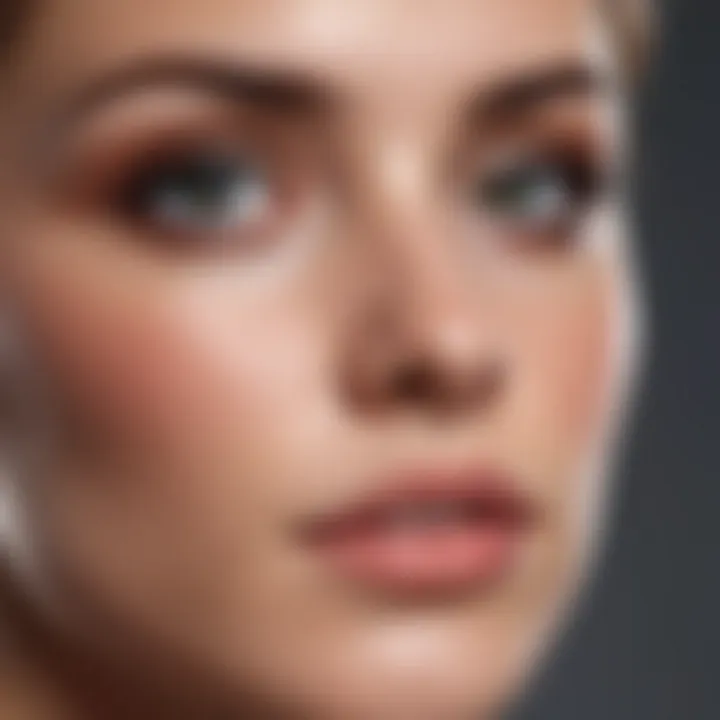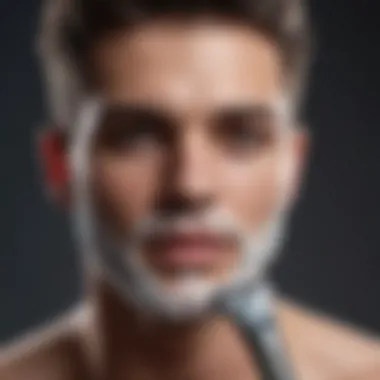Effective Strategies to Prevent Ingrown Hairs


Intro
Ingrown hairs can be both uncomfortable and unsightly, often resulting from improper hair removal techniques. Understanding the reasons behind this condition is vital for prevention. Ingrown hairs occur when hair follicles become obstructed, causing hair to grow back into the skin. Common scenarios where this happens include shaving and waxing, making it important to apply the right strategies for prevention. In this article, we will explore a variety of methods to help minimize the incidence of ingrown hairs, providing practical advice grounded in dermatological principles.
Proper Shaving Techniques
Shaving is one of the most common methods to remove hair, yet it can also lead to ingrown hairs when done incorrectly. To avoid this problem, it’s essential to prepare your skin and hair properly. Here are some tips to keep in mind:
- Exfoliate Before Shaving: Use a gentle exfoliating scrub to slough off dead skin cells. This helps free trapped hairs and allows them to grow with less impediment.
- Use a Sharp Razor: Dull blades can tug on the hair rather than cutting it cleanly. A sharp blade provides a closer shave, thereby reducing the likelihood of hairs becoming ingrown.
- Shave in the Right Direction: Always shave in the direction of hair growth. This minimizes irritation and helps the hair to grow outwards, rather than curling back into the skin.
Maintaining good technique during shaving can significantly lower the chances of hair growing in the wrong direction.
Waxing Care
Waxing is another popular hair removal method. Like shaving, it requires care to prevent ingrown hairs. Follow these steps:
- Choose Quality Wax: Use a high-quality wax that adheres well to the hair, ensuring that it removes the hair from the root without breaking.
- Pre- and Post-Wax Care: It is important to cleanse and exfoliate the skin before waxing. After waxing, apply a soothing lotion or gel. This can help calm the skin and reduce inflammation.
- Avoid Tight Clothing: After waxing, avoid tight clothing for at least 24 hours. Tight garments can cause friction, aggravating the skin and increasing the likelihood of ingrown hairs.
Hydration and Moisturization
Hydrated skin is less prone to irritation. Drinking enough water ensures your skin remains supple. Additionally, moisturizing regularly helps maintain the skin barrier, reducing the risk of clogged pores. Adding non-comedogenic moisturizers, those designed not to block pores, helps prevent ingrown hairs.
Regular Exfoliation
Regular exfoliation can be an essential tool in preventing ingrown hairs. Gentle exfoliation helps to remove dead skin cells and can be achieved through various methods:
- Chemical Exfoliants: Alpha hydroxy acids (AHAs) or beta hydroxy acids (BHAs) can be effective for people prone to ingrown hairs. They penetrate the skin and aid in cellular turnover.
- Physical Exfoliants: Use a soft scrub or a washcloth to gently buff the skin. Avoid harsh exfoliants as they can damage the skin and lead to increased irritation.
Epilogue
Preventing ingrown hairs involves a combination of accurate hair removal methods, aftercare, and regular skin maintenance routines. Education and practical knowledge are key to promoting healthier skin. By following the strategies outlined in this guide, individuals can reduce their risk of encountering this common issue. In the pursuit of well-groomed skin, every small effort counts.
Understanding Ingrown Hairs
Ingrown hairs can be a common yet frustrating skin problem for many people, affecting their comfort and appearance. This section aims to provide a comprehensive understanding of ingrown hairs, shedding light on their nature, causes, and the role different skin types play in their formation. By grasping these fundamental aspects, readers can better appreciate the importance of prevention strategies.
What are Ingrown Hairs?
Ingrown hairs occur when hair curls back or grows sideways into the skin after shaving, waxing, or other hair removal methods. This situation leads to inflammation and the development of small, red bumps. In some cases, it can cause irritation, pain, or even infection. Understanding the definition of ingrown hairs is crucial for recognizing them early and applying appropriate prevention measures.
Moreover, ingrown hairs are not limited to specific demographics. They can affect anyone, regardless of gender or ethnicity. However, people with coarse, curly hair may be more susceptible due to the natural tendency of their hair to curl back into the skin.
Causes of Ingrown Hairs
Several factors can contribute to the development of ingrown hairs. Understanding these causes enables the implementation of effective prevention strategies. Here are some common causes:
- Improper grooming techniques: Shaving against the hair growth direction can lead to more ingrown hairs.
- Inadequate exfoliation: Dead skin cells can block hair follicles, pushing the hair back into the skin.
- Use of dull blades: A worn-out razor may not cut hair cleanly, increasing the chance of hair curling back into the skin.
- Tight clothing: Outfits that constrict the skin can push hair into the follicle.
Awareness of these causes can help individuals modify their grooming routines to reduce risk.
Skin Types and Their Role
Skin type plays a significant role in how prone a person may be to ingrown hairs. Different skin types exhibit unique characteristics, influencing hair growth and shedding. Here’s a closer look:
- Oily skin: Excess oil may cause more buildup of dead skin cells, which can lead to clogged pores.
- Dry skin: Lack of hydration can make skin more prone to irritation and obstruction of hair follicles.
- Sensitive skin: This skin type may react negatively to certain products or techniques, increasing chances of ingrown hairs.
It is crucial for individuals to assess their skin type and adapt their grooming methods accordingly.
Understanding ingrown hairs and their causes can empower individuals to take proactive steps towards prevention.
In summary, acknowledging what ingrown hairs are, their underlying causes, and the influence of skin types lays the foundation for implementing effective strategies to avoid this common skin issue.
The Importance of Proper Grooming
Proper grooming plays a significant role in maintaining skin health and preventing ingrown hairs. The act of grooming encompasses various practices, such as shaving, waxing, and general skin care. Understanding proper grooming techniques can not only enhance individual hygiene but also reduce the occurrence of skin irritations and ingrown hairs, which often result from improper methods.
When it comes to grooming, attention to detail is crucial. Wrong tools or techniques can lead to discomfort, irritation, and adverse effects on skin texture. Investing time in selecting proper grooming habits helps in achieving a smoother skin surface which can enhance overall appearance. Consequently, this consideration can contribute positively to self-confidence.
Moreover, proper grooming reduces the risk of ingrown hairs, which are not only painful but can also lead to infections. By adopting specific strategies and tools, individuals can ensure that their grooming routines are effective and gentle on their skin, ultimately minimizing unwanted side effects.


Choosing the Right Tools
Selecting the right grooming tools is essential for optimal results while minimizing the risk of ingrown hairs. The choice can significantly impact the ease and outcome of the grooming process.
Types of Razors
Razor selection plays a pivotal role in shaving effectiveness. A good razor should have a comfortable grip and allow precise control during use. Safety razors are a popular choice for many, as they can provide a closer shave with less irritation. They often have a single blade which helps avoid pulling hair, decreasing the chances of ingrown hairs. This characteristic makes them suitable for users with sensitive skin.
However, disposable razors can be convenient for travel or short-term use, though they may require more frequent replacement. They often are less effective and might lead to increased irritation if not used properly. In contrast, straight razors offer the closest shave possible but require skill and practice, thus posing a risk for novice users.
Use of Electric Shavers
Electric shavers present an alternative option that can greatly reduce the risk of ingrown hairs. They are designed to be user-friendly and often come equipped with safety features that protect the skin from cuts. Many electric shavers allow for adjustable settings, which can accommodate different hair types and lengths. This flexibility makes them suitable for various grooming preferences.
On the downside, some users may find that electric shavers do not provide as close a shave compared to traditional options. This might lead them to shave more frequently, potentially increasing the risk of skin irritation.
Selection of Waxing Equipment
When considering waxing, selecting the appropriate equipment is vital. High-quality waxing kits often include features that help reduce discomfort during the process. Soft wax tends to be effective for larger areas and is usually removed with cloth strips, making it popular and effective for many users.
Key characteristics of good waxing equipment includes hypoallergenic properties and the ability to maintain skin integrity. If not handled properly, waxing might lead to significant irritation and even breakouts. It is essential to follow usage directions carefully to maximize benefits and minimize adverse effects.
Understanding Hair Growth Direction
Identifying and understanding hair growth direction is critical. Knowing how hair grows can guide the shaving technique to minimize ingrown hairs. For instance, shaving in the direction of hair growth can decrease irritation and reduce the likelihood of hair curling back into the skin.
The hair growth pattern varies from person to person. Observing these patterns can lead to more effective grooming routines. Utilizing methods tailored to individual hair growth direction can enhance the grooming experience and contribute to healthier skin overall.
Frequency of Grooming
The frequency of grooming is another factor that influences the health of the skin. Regular grooming, when done correctly, can prevent hair follicles from becoming blocked and hairs from growing inward. However, over-grooming can also lead to skin irritation and should be avoided.
Finding a balance between maintaining a groomed appearance and allowing skin to rest is essential. Most dermatologists recommend evaluating skin sensitivity and adjusting grooming routines accordingly, perhaps waiting at least a few days between shaves or waxes, depending on the individual’s needs.
Pre-Grooming Preparation
Pre-grooming preparation is a crucial aspect when it comes to preventing ingrown hairs. Taking the time to prepare the skin adequately before hair removal can significantly reduce the likelihood of this common issue. Proper preparation helps to soften hair and skin, making the grooming process smoother and more effective.
Exfoliation Techniques
Exfoliation involves removing dead skin cells from the surface of the skin. This process is important because dead skin can trap hairs, leading to ingrown hairs.
Physical Exfoliation
Physical exfoliation uses a manual method to slough off dead skin. This can be done through various means such as scrubs, brushes, or exfoliating gloves. The key characteristic of physical exfoliation is its immediate tactile feedback, allowing individuals to see and feel the results instantly.
One unique feature of physical exfoliation is its simplicity; it requires no special products aside from basic scrubs or tools found commonly in households. An advantage of this method is that it empowers the user to control the pressure and frequency of exfoliation. However, over-exfoliation can lead to irritation, making it essential to balance its use.
Chemical Exfoliation
On the other hand, chemical exfoliation utilizes acids or enzymes to break down and dissolve dead skin cells. This method is effective for those who have sensitive skin, as it avoids the physical irritation that can come from scrubbing. The main characteristic of chemical exfoliation is its ability to penetrate deeper into the skin layers. This makes it a popular choice for skincare enthusiasts looking to maintain a polished complexion.
The unique feature of chemical exfoliation is its variety of formulations, including AHAs (alpha hydroxy acids) and BHAs (beta hydroxy acids), which can target specific skin issues. One advantage is its efficacy in treating uneven skin tones or reducing acne. However, it is crucial to use these products correctly to prevent chemical burns or excessive dryness.
Hydration and Skin Care
Hydration plays an integral role in pre-grooming preparation. Well-hydrated skin is more pliable, allowing for a closer shave or effective hair removal without the risk of irritation. Using appropriate moisturizers tailored to specific skin types beforehand can allow for a smoother grooming experience. This practice minimizes stress on the skin, helping to prevent potential ingrown hairs.
Warm Compress Application
Applying a warm compress prior to grooming can further aid in opening up hair follicles. This practice helps to soften the hair and skin, providing a more comfortable grooming process. It is a simple step that can yield significant benefits. Using a warm cloth, the user can gently apply it to the targeted area for a few minutes. This action can relax the skin and prepare it for the subsequent hair removal technique, effectively reducing the chance of hairs becoming trapped.
"Proper pre-grooming preparation enhances the overall efficacy of hair removal methods and is key in preventing complications such as ingrown hairs."
In summary, with proper exfoliation, hydration, and warm compresses, individuals can greatly lower the risk of ingrown hairs. These practical steps lay a strong foundation for a smooth grooming experience.
Grooming Techniques to Avoid Ingrown Hairs
Minimizing the occurrence of ingrown hairs requires attention to grooming techniques. Adopting proper practices is crucial in ensuring healthier skin and reducing the risks associated with ingrown hairs. The way one shaves, waxes, or uses depilatory methods directly influences the likelihood of developing this common skin issue. Understanding these techniques can make all the difference.
Shaving Practices


Shaving Cream Usage
Using shaving cream is essential for a smooth shave. This product serves several important functions. It hydrates the hair, making it softer and easier to cut. A quality cream also creates a barrier between the skin and the blade. This reduces friction, thereby lowering the chances of irritation. Look for creams that contain moisturizing ingredients; they are often more effective in preventing irritation.
However, be mindful of the ingredients in your shaving cream. Some people might have allergic reactions to certain chemicals or fragrances, which can worsen the skin condition. Choosing a cream that is fragrance-free and designed for sensitive skin can be a prudent choice for those prone to irritation.
Shaving Angle and Technique
The angle at which you shave has a significant influence on skin health. Generally, a 30-degree angle is deemed optimal for most blade types. This angle allows for effective cutting while minimizing the acne potential for ingrown hairs. It is crucial to apply light pressure when shaving. Pressing too hard can result in cuts or irritation, which may lead to ingrown hairs developing.
Additionally, always shave in the direction of hair growth. Shaving against the grain might feel smoother, but it often increases the chance of hair growing back into the skin. Adjusting your angle and ensuring the correct technique is an important step towards a more successful shave.
Post-Shave Care
Post-shave care is as important as the shaving itself. After you finish shaving, the skin needs proper treatment to thrive. Rinsing the area with cold water can help reduce any swelling or irritation. After drying the skin, applying a gentle, alcohol-free aftershave or moisturizer is essential. Products with soothing ingredients like aloe or chamomile can offer relief and hydration.
Neglecting post-shave care can lead to dryness and discomfort. This discomfort can increase the risk of ingrown hairs, as irritated skin is more susceptible to various conditions. Paying attention to post-shave care is crucial for lasting skin health.
Depilatory Methods
Depilatory methods, such as creams and lotions, can offer an effective alternative to traditional shaving. These products dissolve hair above the skin's surface, reducing the risk of ingrown hairs. However, they may also cause skin irritation for some users. Always do a patch test before using a new depilatory product. Consider using creams formulated for sensitive skin to minimize potential negative impacts.
Waxing Recommendations
Waxing can be a long-lasting solution for hair removal, but it carries its own set of challenges. One of the advantages of waxing is that it removes hair from the root, which may lead to finer regrowth. This process can be less likely to result in ingrown hairs compared to shaving. However, taking care with wax quality and applying it correctly is vital.
When waxing, ensure the skin is clean and dry beforehand. After the procedure, applying a soothing agent can help calm irritation. Regular waxing can reduce the likelihood of hair returning in a short time, but it is crucial to follow proper aftercare to avoid the development of ingrown hairs.
Post-Grooming Care
Post-grooming care is a critical aspect of managing skin health and preventing ingrown hairs. After shaving or waxing, the skin can be sensitive and prone to irritation. Proper care helps soothe this sensitivity and can significantly reduce the likelihood of ingrown hairs developing. Key elements of post-grooming care include moisturization and targeted treatments, both of which serve to calm the skin after the trauma of hair removal.
Moisturization
Moisturization is essential because it restores hydration to the skin, which may become dry and irritated after grooming. When the skin is well-hydrated, it remains supple, making it less likely for hairs to become trapped under the skin's surface.
Good moisturizers can also help maintain the skin's barrier, which protects against environmental factors and bacteria. Look for products containing ingredients like hyaluronic acid or glycerin, as these are effective at drawing moisture into the skin.
In addition, applying moisturizer immediately after grooming can enhance its absorption. This practice not only alleviates discomfort but also ensures that skin remains pliable, minimizing the potential for ingrown hairs.
Targeted Treatments
Targeted treatments can offer immediate relief for areas that are prone to ingrown hairs. These treatments typically focus on preventing future occurrences and treating existing stubborn ingrown hairs.
Ingrown Hair Serums
Ingrown hair serums are specifically designed to address and prevent this particular issue. The key characteristic of these serums is their formulation, often containing exfoliants like salicylic acid or glycolic acid. These ingredients work to chemically exfoliate the skin, helping to free trapped hairs and prevent new ones from becoming ingrown.
The unique feature of most ingrown hair serums is their lightweight texture, which allows for quick absorption without leaving a heavy residue on the skin. This makes them a popular choice for those wary of clogged pores post-grooming. However, it is important to note that some serums can cause initial irritation in sensitive skin types.
Natural Remedies
Natural remedies offer a gentler approach to treating ingrown hairs and soothing irritated skin. Many people prefer these because they often contain fewer synthetic chemicals. Common natural remedies may include tea tree oil and aloe vera, known for their anti-inflammatory and healing properties.
The distinctive feature of natural remedies is their versatility and low risk of side effects. Aloe vera, for instance, not only hydrates the skin but also has anti-bacterial properties that can prevent infections around ingrown hairs. However, while these remedies can be effective, their results might vary, and they could take longer to produce noticeable outcomes.
Post-grooming care is not just an afterthought; it is crucial in maintaining skin integrity and preventing long-term issues like ingrown hairs.
Lifestyle Factors Influencing Ingrown Hairs
Understanding how lifestyle choices impact skin health is vital in the quest to prevent ingrown hairs. Factors such as diet, hydration, and stress levels can significantly influence skin conditions and the body's ability to manage hair growth. By addressing these underlying issues, individuals can reduce the incidence of ingrown hairs and promote overall skin vitality.
Diet and Hydration
The food we consume plays a fundamental role in skin health. A balanced diet rich in vitamins, minerals, and antioxidants can bolster the skin's resilience against various irritants that lead to ingrown hairs. Specifically, vitamins A, C, and E are critical for skin repair and regeneration.
Staying hydrated is equally important. Adequate water intake maintains skin elasticity and helps flush out toxins. When skin is well-hydrated, it is less likely to become dry or irritated, which can contribute to hair becoming trapped under the skin's surface. Incorporating foods that are high in water content, like cucumbers and watermelon, can also assist in achieving optimal hydration.
Key dietary considerations include:
- Consuming a variety of fruits and vegetables.
- Including healthy fats, such as those from avocados and nuts.
- Limiting processed foods and sugars, which can cause inflammation.


Stress and Skin Health
Stress is another considerable factor affecting skin issues, including the likelihood of ingrown hairs. When the body experiences stress, it releases hormones such as cortisol, which can lead to inflammation and skin irritation. Both of these conditions can worsen the occurrence of ingrown hairs.
Managing stress through techniques such as meditation, exercise, or even leisure activities can improve skin health. Regular physical activity increases blood flow and promotes the delivery of nutrients to the skin, making it more resilient. Furthermore, proper sleep is often overlooked as a stress reliever and is vital for skin recovery.
Strategies to manage stress include:
- Practicing mindfulness or meditation.
- Ensuring a regular exercise routine.
- Prioritizing sufficient sleep every night.
Ultimately, recognizing the interconnectedness of these lifestyle factors can help individuals make informed choices that contribute to clearer, healthier skin and reduce the likelihood of ingrown hairs.
Debunking Myths about Ingrown Hairs
Understanding ingrown hairs involves addressing common misconceptions that often cloud public perception. Myths can lead to improper treatments and unhelpful skincare practices. By debunking these misconceptions, we can provide a clearer view of ingrown hairs and the best strategies to prevent them. This offers readers clarity, empowering them to take better care of their skin.
Common Misconceptions
One widespread myth about ingrown hairs is that shaving causes them. While improper shaving techniques can lead to ingrown hairs, simply shaving does not mean that one will automatically experience this issue. Factors like hair texture, skin type, and post-care are equally important. It’s crucial for individuals to understand their skin and hair characteristics to address ingrown hair development effectively.
Another misunderstanding is that ingrown hairs are solely an issue for those with curly hair. Although curly hair can be more likely to grow inward, people with straight hair can also experience ingrown hairs. This reality makes it vital for everyone, regardless of hair type, to adopt appropriate grooming habits.
Furthermore, some believe that using cream or lotion after shaving will increase the likelihood of ingrown hairs. In fact, moisturization serves to hydrate the skin, making it more supple and less prone to irritation. The right skincare products can significantly lower the risk of ingrown hairs.
This is a crucial point for maintaining healthy skin. Recognizing these common misconceptions allows readers to focus more on their grooming techniques than on misguided beliefs.
The Role of Sweating
Another aspect deserving attention is the common belief that sweating exacerbates ingrown hairs. While sweat itself does not cause ingrown hairs, it can lead to skin irritation and clogged pores, which can further complicate the issue. This irritation might contribute to the development of ingrown hairs in some individuals, particularly those who do not maintain proper skin hygiene.
Engaging in activities that increase sweat production demands attention to skin after the fact. Ensuring a clean and dry post-exercise routine is essential. Showering promptly after sweating and using appropriate cleansers can remove excess oils and dirt. A clean surface reduces the chance that hair will become trapped under the skin, thus decreasing the likelihood of ingrown hairs.
It is important to remember that proper hygiene, along with effective grooming habits, plays a significant role in preventing ingrown hairs.
To summarize, debunking myths related to ingrown hairs is not just about correcting falsehoods. It is about equipping individuals with a clearer understanding of their skin and hair. With this knowledge in hand, readers can improve their grooming practices and effectively reduce the occurrence of ingrown hairs.
When to Seek Professional Help
Seeking professional help for ingrown hairs can be crucial. While many individuals can manage mild cases with home remedy and proper care, some situations require more specialized attention. Recognizing when to consult a healthcare provider is vital for preventing lasting skin damage and ensuring proper treatment.
Ingrown hairs can sometimes lead to infections, scarring, and persistent discomfort. Therefore, understanding the elements indicating a necessity for professional intervention is essential. Such awareness contributes to immediate action and helps maintain skin health in the long term.
Identifying Severe Cases
There are several signs that might indicate a more serious issue stemming from ingrown hairs. If symptoms escalate beyond mild irritation, you may need to seek help. Key indicators include:
- Persistent redness and swelling: If these symptoms do not resolve with basic first aid, it may be time to consult a doctor.
- Pus formation: The presence of pus suggests an infection, which requires medical attention.
- Increased pain: If the discomfort becomes severe or worsens, it’s advisable to reach out for professional care.
- Scarring: Any noticeable changes in the skin’s texture or color should be examined by a dermatologist.
Recognizing these signs early can minimize complications and promote quicker recovery.
Consulting with a Dermatologist
When the situation demands it, consulting with a dermatologist is a wise step. These specialists can provide invaluable insights into the effective management of ingrown hairs. Here are some benefits of such consultations:
- Accurate Diagnosis: A dermatologist can evaluate the severity of your condition and rule out other skin issues.
- Targeted Treatments: They may recommend specific treatments, including antibiotic creams or other medications for severe infections.
- Personalized Care Plan: Based on individual skin types and conditions, dermatologists can develop tailored plans that include customized grooming advice and skincare recommendations.
"Managing ingrown hairs is not just about immediate relief. It’s about maintaining healthy skin for the future."
By recognizing the signs of severe cases and understanding when to consult a dermatologist, individuals can better manage their skin health. Proactive steps are vital for avoiding complications and achieving a smoother skin appearance.
Finale
In summary, the prevention of ingrown hairs requires a multifaceted approach that integrates effective grooming practices with thoughtful skincare. Understanding the nature of ingrown hairs and the factors that contribute to their occurrence is crucial for anyone seeking to minimize skin irritation and promote a smoother appearance. By acknowledging the role of proper tools, techniques, and post-grooming care, individuals can significantly reduce the likelihood of developing ingrown hairs.
Summary of Best Practices
To encapsulate the key strategies outlined in this comprehensive guide, consider the following best practices:
- Choose Appropriate Tools: Using high-quality razors, electric shavers, or waxing supplies can make a significant difference in your grooming routine. Always select tools that fit your skin type and hair texture.
- Prep the Skin: Always exfoliate before grooming to remove dead skin cells and reduce the chance of hairs becoming trapped. Utilize both physical and chemical exfoliants as appropriate for your skin type.
- Mind Hair Growth Direction: Shaving or waxing in the direction of hair growth minimizes the risk of hairs curling back into the skin. Understanding your hair growth patterns is essential.
- Post-Grooming Care: After grooming, apply moisturizers or specialized serums to soothe the skin and aid recovery. Regular hydration supports skin health overall.
- Maintain Overall Skin Health: A balanced diet, adequate hydration, and stress management can contribute to better dermatological health, reducing the incidence of ingrown hairs.
Final Thoughts on Ingrown Hair Prevention
Ultimately, the journey to prevent ingrown hairs is one of awareness and careful management. It involves understanding individual skin types and adapting grooming habits accordingly. Implementing these strategies can lead to smoother skin and a more confident you. Staying informed and proactive in your skin care will yield the best results. Remember, if successful prevention proves challenging, consulting with a dermatologist is a wise step to address more serious concerns.
"Proper grooming is as essential as maintaining a balanced life, impacting both aesthetics and self-esteem."
Through the engagement with this article, readers should feel equipped with valuable knowledge and practical tips for reducing the occurrence of ingrown hairs. By focusing on these strategies, individuals can achieve not only the appearance they desire but also foster healthier skin.



